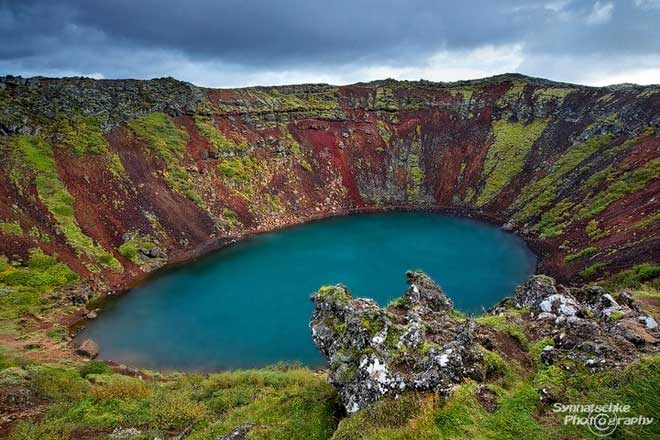Kerid Crater Lake in Iceland is one of the most beautiful lakes in the country. The lake was formed approximately 3,000 years ago when the magma chamber of a volcano collapsed, creating a funnel-shaped crater that is 55 meters deep.
This stunning turquoise lake is part of the Tjarnarholar crater group located in the Grimsnes area of South Iceland. At around 3,000 years old, Kerid is half the age of most craters found in Iceland. This is the main reason why the slopes of Kerid are red rather than the black typical of volcanic formations, as the iron deposits here remain fresh.

Kerid Crater Lake in Iceland.
Kerid is about 55 meters deep and 170 meters wide. The lake’s deep turquoise color is due to minerals leaching from the surrounding rocks, which “dye” the water a distinctive blue.
Scientists believe that Kerid was once a conical volcano. After an eruption, it is thought that the volcano depleted its magma reserves, causing the ground to collapse and leading to the formation of the lake we see today. What makes Kerid Crater unique is that it was formed by a collapsing volcano rather than an explosive eruption.
Kerid Crater is a very popular destination for tourists. It is located in the volcanic region next to the Golden Circle—Iceland’s most famous sightseeing route. This site is also a favorite among photographers, not only for the lake’s unique color but also for the striking red and black volcanic rocks surrounding it. These colors have earned Kerid Crater the nickname The Eye of the World.
Legend has it that Kerid Crater Lake is connected to a lake on Burfell Mountain. Therefore, when the water level in Kerid decreases, the water level in the lake on Burfell increases, and vice versa.
In the summer, the clear blue water and the red volcanic rocks create a stunning scene at Kerid Crater during sunset. In winter, the lake freezes over, and snow covers everything. The view of the lake when snow falls is still beautiful; however, the ice can make the paths quite slippery and dangerous.


















































